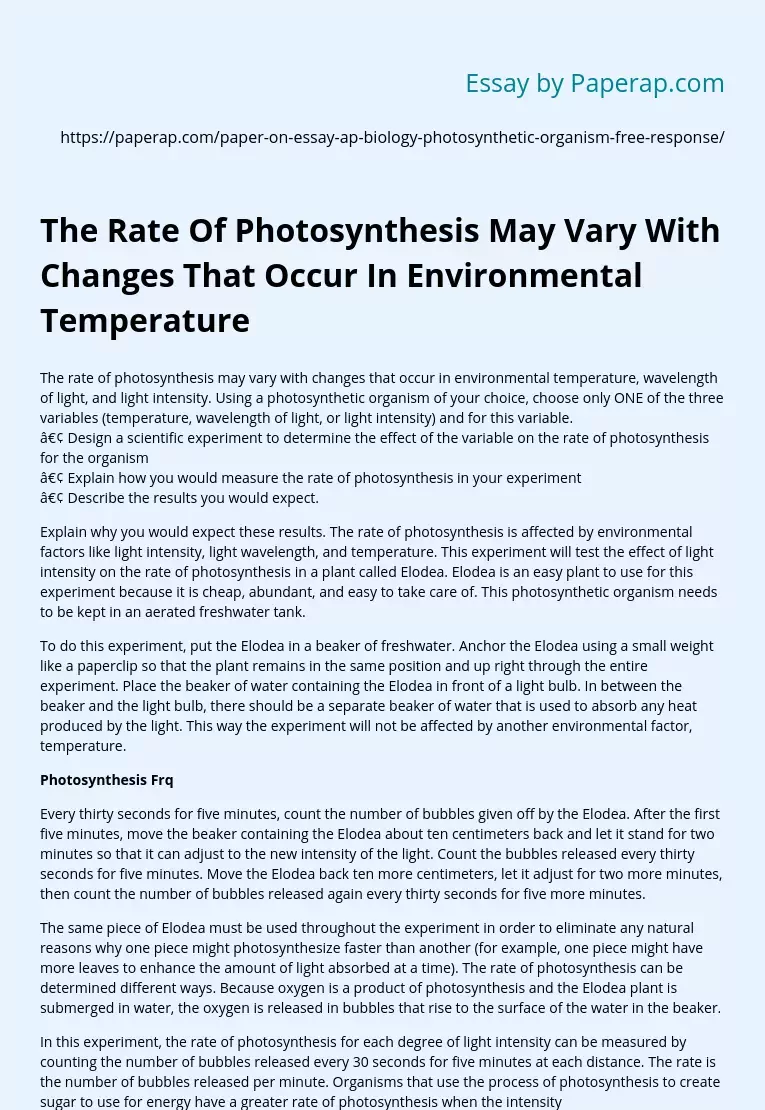Photosynthesis Rate and Temperature
The rate of photosynthesis may vary with changes that occur in environmental temperature, wavelength of light, and light intensity. Using a photosynthetic organism of your choice, choose only ONE of the three variables (temperature, wavelength of light, or light intensity) and for this variable.
• Design a scientific experiment to determine the effect of the variable on the rate of photosynthesis for the organism
• Explain how you would measure the rate of photosynthesis in your experiment
• Describe the results you would expect.
Explain why you would expect these results. The rate of photosynthesis is affected by environmental factors like light intensity, light wavelength, and temperature. This experiment will test the effect of light intensity on the rate of photosynthesis in a plant called Elodea. Elodea is an easy plant to use for this experiment because it is cheap, abundant, and easy to take care of. This photosynthetic organism needs to be kept in an aerated freshwater tank.
To do this experiment, put the Elodea in a beaker of freshwater.
Anchor the Elodea using a small weight like a paperclip so that the plant remains in the same position and up right through the entire experiment. Place the beaker of water containing the Elodea in front of a light bulb. In between the beaker and the light bulb, there should be a separate beaker of water that is used to absorb any heat produced by the light. This way the experiment will not be affected by another environmental factor, temperature.
Photosynthesis Frq
Every thirty seconds for five minutes, count the number of bubbles given off by the Elodea.
After the first five minutes, move the beaker containing the Elodea about ten centimeters back and let it stand for two minutes so that it can adjust to the new intensity of the light. Count the bubbles released every thirty seconds for five minutes. Move the Elodea back ten more centimeters, let it adjust for two more minutes, then count the number of bubbles released again every thirty seconds for five more minutes.
The same piece of Elodea must be used throughout the experiment in order to eliminate any natural reasons why one piece might photosynthesize faster than another (for example, one piece might have more leaves to enhance the amount of light absorbed at a time). The rate of photosynthesis can be determined different ways. Because oxygen is a product of photosynthesis and the Elodea plant is submerged in water, the oxygen is released in bubbles that rise to the surface of the water in the beaker.
In this experiment, the rate of photosynthesis for each degree of light intensity can be measured by counting the number of bubbles released every 30 seconds for five minutes at each distance. The rate is the number of bubbles released per minute. Organisms that use the process of photosynthesis to create sugar to use for energy have a greater rate of photosynthesis when the intensity of the light source is the greatest. If light is far away from the leaves of a plant, for example, then it takes more time for the light to be absorbed and used in photosynthesis.
When it takes more time for the light to reach the leaves, the rate of photosynthesis decreases. As the light intensity increases, I would expect the rate of photosynthesis to increase as well. Therefore, I would expect that when the Elodea is closest to the light bulb, the rate of photosynthesis would be the greatest. My hypothesis would be: If light intensity affects the rate of photosynthesis, and the rate of photosynthesis is measured using the amount of oxygen given off by Elodea with a light bulbs placed at different distances, then the rate of photosynthesis in Elodea will be greatest when the intensity of the light bulb is greatest.
Photosynthesis Rate and Temperature. (2019, Dec 05). Retrieved from https://paperap.com/paper-on-essay-ap-biology-photosynthetic-organism-free-response/

